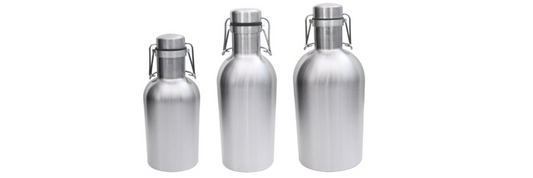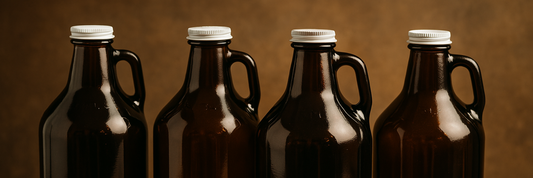The craft beer industry is no stranger to innovation, from unique flavors to creative packaging. One trend that has gained significant traction is the use of tall cans. These sleek, larger cans have become a favorite among breweries and consumers alike. In this article, we’ll explore the history, benefits, and impact of tall cans in the craft beer world, as well as the broader trends driving their popularity.
What is a Tall Can?
The tall can — also known as the tallboy, king can or pounder — isn't new. Milwaukee-based Schlitz Brewing Company started selling them in the 1950s.
A tall can refers to a larger beer can, typically ranging from 16 ounces to 19.2 ounces. Its sleek design and increased volume make it distinct from standard 12-ounce cans. Once primarily used for energy drinks or select beverages, tall cans have found a prominent place in the craft beer industry as a versatile and attractive packaging option.
What is a Sleek Can? Sleek Can vs Other Can Types
What is Slim Can? Dimensions and Sizes of Slim Cans

What Size Is a Tall Can?
A "tall can" typically refers to beer cans larger than the standard 12-ounce size, with common sizes including 16 ounces and 19.2 ounces. These cans are taller and slimmer than traditional cans, offering a sleek, modern appearance and more volume per serving. Below is a detailed breakdown of the most common tall can sizes and their uses:
16 Ounce Can (Beer Cans)
- Dimensions: About 6.2 inches tall and 2.6 inches in diameter.
- Volume: Holds 16 fluid ounces.
- Popularity: Widely used by craft breweries for individual servings and four-packs.
- Purpose: Ideal for showcasing high-quality craft beers and specialty brews.

19.2 Ounce Can (Stovepipe Can)
- Dimensions: Approximately 7 inches tall and slightly slimmer than a pint can.
- Volume: Holds 19.2 fluid ounces, nearly a pint and a half.
- Popularity: Frequently found in convenience stores, stadiums, and events.
- Purpose: Designed for single servings, offering a larger portion without requiring a multi-pack.
24 Ounce Can (Tallboy)
- Dimensions: Taller than stovepipe cans, often exceeding 7.5 inches.
- Volume: Holds 24 fluid ounces, equal to two standard 12-ounce servings.
- Popularity: Common for larger beer brands, less frequent in the craft beer market.
- Purpose: Targeted at consumers seeking more volume in a single can.
500 mL Can (European Standard Tall Can)
- Dimensions: Similar in height to a pint can, slightly wider.
- Volume: Approximately 16.9 ounces (500 milliliters).
- Popularity: Common in Europe and increasingly seen in North American craft beer.
- Purpose: Bridges the gap between pint and stovepipe cans.

The Rise in Popularity of Tall Cans
Tall cans have become a major force in the craft beer industry, with sales steadily increasing over the years. Consumers are drawn to these cans for their modern appearance and practicality. Brewers, in turn, see them as an opportunity to differentiate their products on store shelves and enhance the drinking experience for their customers.
Several factors contribute to the growing popularity of tall cans:
- Convenience: The larger size reduces the need for multiple servings while maintaining portability.
- Aesthetic Appeal: Tall cans offer more space for eye-catching designs, making them a marketing asset.
- Environmental Benefits: Aluminum cans are lightweight, recyclable, and cost-effective, aligning with sustainability goals in the beverage industry.
Benefits of Tall Cans
The widespread adoption of tall cans has advantages for both consumers and producers:
For Consumers
- Convenience: With more beer per can, tall cans cater to those who want a single serving that lasts longer without compromising portability.
- Freshness: Aluminum cans prevent light and oxygen from affecting the beer, ensuring a fresher taste compared to bottles.
For Brewers
- Cost Efficiency: Aluminum cans are lighter to transport and easier to store, reducing overall costs.
- Marketing Potential: The extra surface area on tall cans provides ample room for branding and creative artwork, helping craft breweries stand out in a competitive market.
Economic Impact and Market Trends
The adoption of tall cans isn’t just a trend—it’s driving measurable economic impacts in the craft beer sector. With the shift toward premium packaging, breweries are experiencing increased revenue as customers are willing to pay more for products in tall cans.
This trend aligns with broader consumer preferences for premium experiences, even in everyday purchases. As the craft beer market matures, breweries are exploring innovative ways to appeal to a wider audience while retaining their loyal customers.
Challenges and Opportunities
Despite their advantages, tall cans come with some challenges for brewers:
- Increased Competition: As tall cans grow in popularity, breweries must work harder to differentiate their products.
- Production Adjustments: Switching to tall cans may require investments in new equipment and packaging processes.
However, these challenges also present opportunities. Breweries can use tall cans to:
- Target new customer segments, such as casual beer drinkers or those seeking convenience.
- Experiment with new designs and flavors to maintain excitement in their product lines.
Why Tall Cans Are Here to Stay
Tall cans represent more than a packaging choice—they embody the evolution of consumer expectations in the craft beer industry. They balance practicality with aesthetic appeal, offering benefits for both breweries and drinkers. As sustainability and premium experiences become central to purchasing decisions, tall cans are poised to remain a staple of the craft beer world.
Conclusion
The rise of tall cans is a testament to the craft beer industry’s ability to adapt and innovate. By embracing this packaging format, breweries are tapping into a growing market demand while enhancing their brand identity. Whether you’re a craft beer enthusiast, a producer, or a casual drinker, tall cans offer a fresh perspective on enjoying beer.
As the trend continues to grow, it’s clear that tall cans are more than a passing fad—they’re a long-term game-changer in the craft beer industry.









